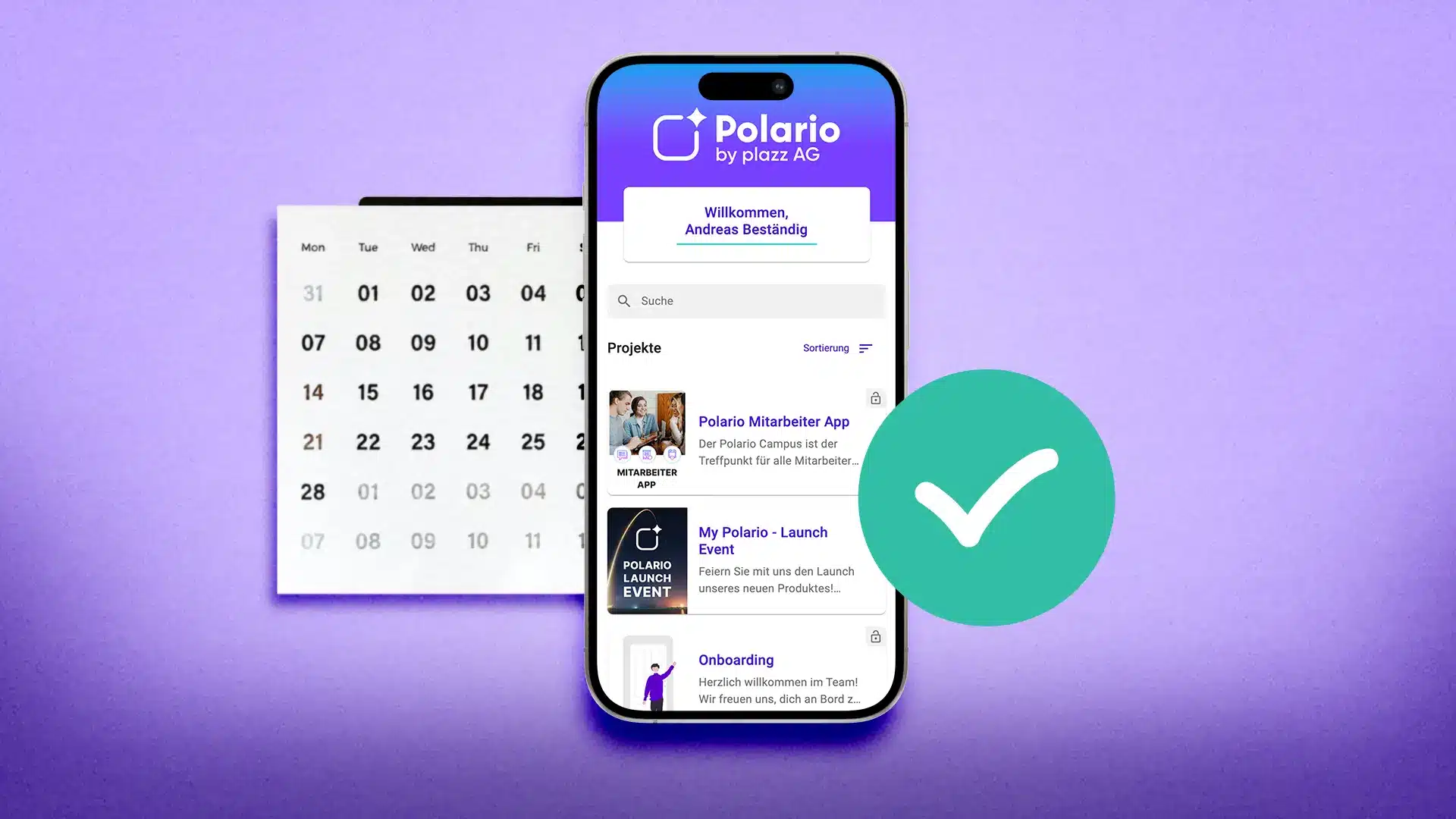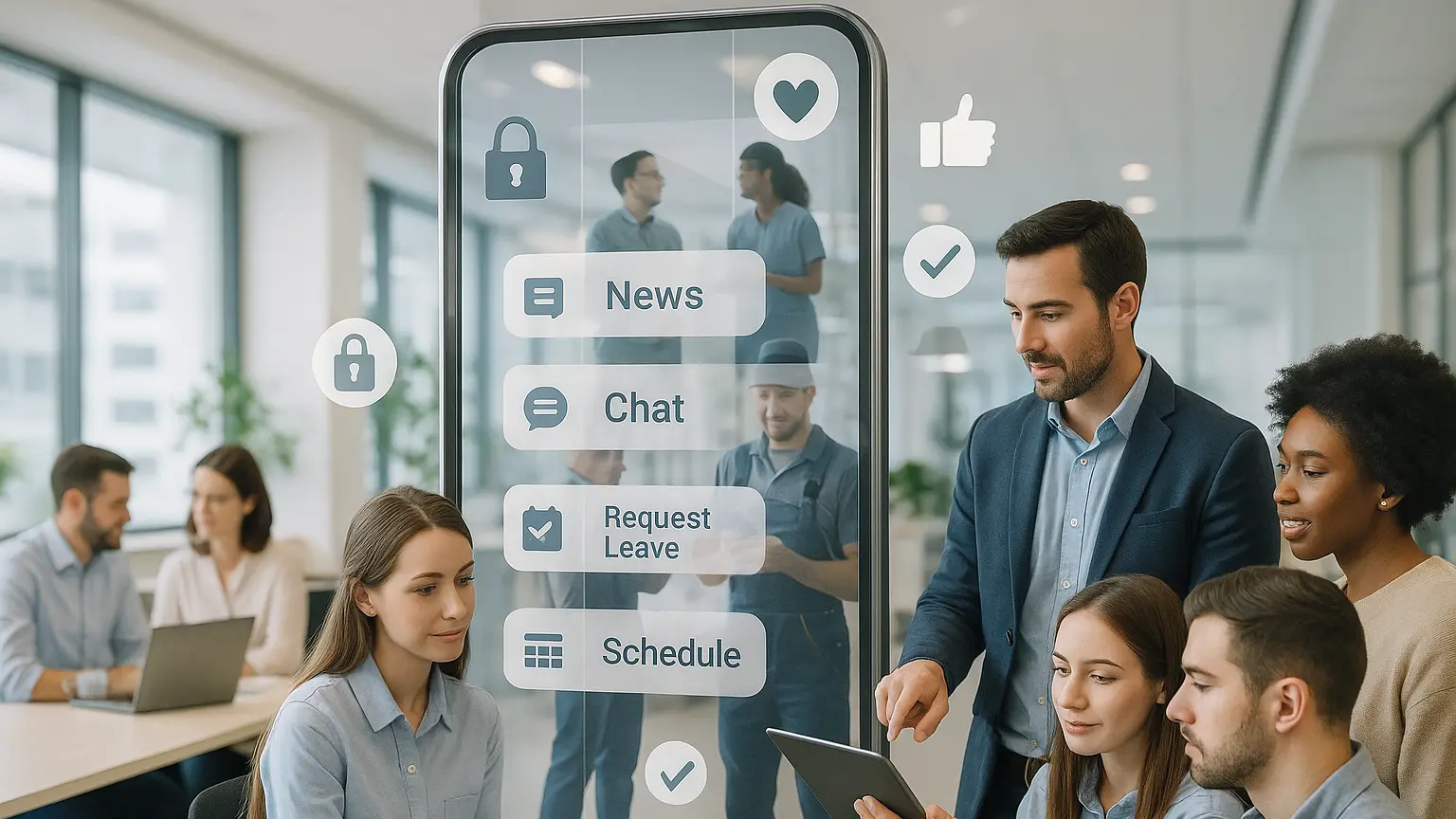In many companies, employee apps are now the backbone of internal communication – especially where not every employee is at their desk every day. However, introducing an employee app means much more than just providing a technical solution. If you want to introduce your employee app successfully, you need to plan strategically, take cultural hurdles seriously and design the app in such a way that it actually adds value for the workforce.
In this article, we show how the introduction is successful, what is crucial after the rollout and how the app can be anchored in employees’ everyday lives so that it is used permanently – not out of compulsion, but out of conviction.
The employee app as a tool, not a project
The first step on the way to a successful launch is to set clear objectives. An employee app is not an end in itself and should not be viewed as a technical project in isolation. Rather, it must be a tool for specific problems and requirements in everyday working life. Do you want to simplify internal communication? Digitise processes such as holiday requests or sick notes? Or perhaps increase employee motivation through greater transparency and participation? Without a clear definition of objectives, the introduction will quickly get lost in feature wish lists that nobody uses in the end.
An equally decisive aspect is the precise knowledge of the target group. The requirements of employees in administration differ considerably from those in production or field service. Those who work on a PC every day do not need an app for information that they can find on the intranet anyway. For employees without a fixed workstation or company email address, on the other hand, the app can become the central communication channel – provided it is easy to use, available on any device and understandable without training.

Introduce an employee app in 4 weeks
Find out how to introduce your employee app in just 4 weeks and improve communication in the long term.
Building trust: Data protection, voluntariness and participation
A key success factor – and at the same time an often underestimated hurdle – is the issue of data protection. Clear rules are needed, especially if employees are to use the app on private devices: What data is collected? Is use voluntary? Who has access to content and analyses? If the works council is involved at an early stage and communication is transparent, many reservations can be overcome from the outset. Trust is the basis of every digital solution, and anyone who ignores this risks a silent refusal among the workforce.
Introduction is not a conclusion, but the beginning
The app is technically ready, the functions work – and yet hardly anyone uses it? This scenario is common in practice. The reason: the launch was seen as the end. In reality, the crucial part begins now. A successful onboarding process ensures that all employees learn about the app, understand it and experience its benefits. A personal invitation by letter or from the manager is often more effective than an impersonal email. Introductory videos, simple step-by-step instructions or internal multipliers who answer questions contribute significantly to initial use.
Early added value instead of a compulsory task
But onboarding alone is not enough. It is crucial that the app offers
Especially in the initial phase, it is crucial to create so-called ‘quick wins’. This means that the app has to solve a real problem in the first few days – whether it’s avoiding unnecessary queries, saving a phone call or displaying team information transparently. This is the only way to create the feeling: ‘This app really helps me.’
Acceptance is not a matter of course
People are naturally sceptical about change, especially when it comes from the company management. However, if the app is not seen as a controlling or purely informative system, but as a tool that saves time, shortens distances and simplifies everyday working life, this attitude changes. It is important that the benefits are not only communicated in theory, but that they can be experienced in practice.
A common mistake is to present too many functions at once – which leads to overload rather than enthusiasm. It is better to start with a few, but relevant functions that offer clear added value. Only once these have been established can the app be expanded step by step.
Avoid the empty start
If, on the other hand, the app does not show any immediate benefit, it quickly loses relevance. It is perceived as a ‘nice to have’ – or worse still: as an additional burden. In this case, a single negative user experience – such as a confusing interface or a malfunctioning login – is often enough to permanently destroy motivation. And this turns an otherwise useful solution into a shelf warmer.
Long-term success therefore depends heavily on whether it is possible to make a concrete benefit tangible at an early stage – not only for the company, but above all for the employees. Only when the daily use of a smartphone is associated with real added value will the app become a habit. And only then is it more than just a tool: It is an integral part of work organisation.
How to actively bring employees into the app
Many companies still rely on traditional email communication when it comes to introducing new digital tools. The problem with this is that the very employees for whom an employee app would be particularly relevant – such as employees in production, field service or care – are often not reachable via this channel. If you want to introduce your employee app successfully, you need to close this communication gap in a targeted manner. A successful launch doesn’t just mean making the app technically available, but actually reaching people – with a language, a medium and an approach that is tailored to their working reality.
Personal communication plays a central role here. App demos can be incorporated into team meetings, staff meetings or the daily shift handover to show not only how the app works, but also what it is used for. Anyone who can experience live how easy it is to open a duty rota or apply for holiday is much more likely to test the app themselves. Notices with QR codes in highly frequented areas such as lounges, lockers or canteens offer an additional opportunity to address employees – provided they are visually appealing, specific and contain clear calls to action.
A particularly effective lever for dissemination is the behaviour of managers. Employees are strongly orientated towards what their direct superiors do – not just what they say. If the team leaders themselves regularly share information via the app, post status updates or answer queries exclusively via the app, its use is quickly perceived as normality. The opposite is also true: if managers ignore the app itself and continue to communicate via WhatsApp or a notice board, the app loses credibility and becomes a parallel solution without authority.

Employee app and internal communication channels in comparison
Comparison of internal communication channels: analyse the pros and cons to find the best solutions for your company.
In addition, targeted incentives can help to lower the initial threshold for use. A small competition for all those who register within the first week generates attention – as does exclusive content or functions that are only available via the app. Examples of this include internal information that is not distributed via a notice board or small benefits such as a digital canteen voucher that can only be accessed in the app.
Gamification elements have also proven their worth – but they should be used with a sense of proportion. Small awards such as ‘early starter of the month’ or an internal user ranking can create playful motivation as long as they do not degenerate into competition or pressure. It is important that the appreciation of use is clearly in the foreground – not the mere ‘ticking off’ of functions.
Ultimately, the successful introduction of an employee app always requires an initial impulse – a conscious event or signal that makes it clear: this app is important, it is part of our everyday working life and it is made for you. Its mere existence is not enough. Only when the app has an emotional, social and functional impact on employees’ everyday lives does its real effect begin. And it’s not just the technology that’s crucial – it’s the way in which you bring the app into the company.
How the app is becoming an indispensable part of everyday working life
For the app to remain relevant in the long term, it must offer more than just news and documents. It should simplify processes, save time and enable interactions that were previously cumbersome or not possible at all. The more useful functions are bundled centrally in one place, the more likely the app is to become a daily companion.
A good example is the integration of operational processes: submitting sick notes by photo, swapping shifts or requesting holidays – without forms or detours. Exclusive content is just as important: Information from the management, internal job vacancies, birthday greetings or benefits such as employee discounts make the app an emotional experience. Formats such as surveys, feedback options or a ‘wall of fame’ for special achievements also promote identification with the app – and therefore with the company.
The app can also help to convey the corporate culture – especially in times of hybrid forms of work. When employees share their teams’ successes, take part in photo competitions or give feedback on internal projects, a digital space is created that promotes community – beyond pure information.

The best employee app: how to make the right choice
The search ends here: Discover the top employee app for your company from our comparison of well-known providers!
Conclusion: Successfully introducing an employee app means creating real benefits
The introduction of an employee app is not an IT project that ends with the go-live. It is a change process that affects a company’s communication, culture and working methods. The app can only realise its potential if it creates real benefits, is supported by managers and is consistently embedded in everyday life.
Instead of focussing on as many functions as possible, it is worth starting where the added value for the workforce is greatest – and developing the app step by step into an indispensable tool. That way, it is not only used, but wanted.




